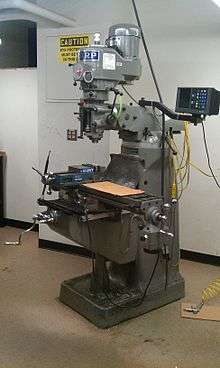Bridgeport (machine tool brand)



Bridgeport is a brand of milling machines and machining centers, which are machine tools used in the machining industries. The brand was produced by Bridgeport Machines, Inc. from 1938 until 2004, when it was acquired by Hardinge, Inc., its current owner. Hardinge is a multinational corporation whose machine tool brands include Hardinge, Bridgeport, Kellenberger, Hauser, Tripet, and Tschudin. It currently has subsidiaries in England, Germany, Switzerland, China, and Taiwan, ROC.
History
The original corporation was founded in Bridgeport, Connecticut and started selling its machines in 1938. It became famous in the following decades for these small- and medium-sized vertical milling machines, with their iconic form of a quill-equipped multiple-speed vertical milling head with a ram-on-turret mounting over a knee-and-column base. The American Precision Museum's biography of Rudolph Bannow[1] reports that he conceived the iconic design in 1936 as the logical machine on which to mount the milling head already being built by the Bridgeport Pattern and Model Works (which he owned with partner Magnus Wahlstrom). The first Bridgeport milling machine (serial number 1) is on display at the Museum.[2]
Bridgeport's manual milling machines have been so successful and ubiquitous that, within the machining industries and among hobbyists, the Bridgeport is an archetypical example of that class of machine, and the term "Bridgeport" is often used to refer to any vertical milling machine of the same configuration, regardless of make. Many other companies have cloned the form. Today the Bridgeport brand still produces this configuration in both manual and CNC versions, although tool-changer-equipped machining centers are now equally prominent members of the product line.
Bridgeport manual milling machines have come in many types and sizes over the years, including (but not limited to) the C head (original), R head (heavy duty C head), M head, J head (and high speed, 5440 RPM version), 2J1 1/2 head (1.5 HP Vari-Speed), 2J2 (2HP Vari-speed), and Series II head (4HP Vari-speed). All of the heads offer variable speeds, the earlier ones via a step pulley (cone pulley) and the later ones via electrically or electronically modulated variable-speed drive. Typical table sizes are 9″ × 49″ (Y and X, respectively) and 10″ × 54″. Machine tapers for toolholding include Morse tapers (on early models) and the R8 taper (a widely used standard that Bridgeport created) on most models. Both Morse and R8 allow for both collets and solid holders; and a drill chuck can be held by either of the latter. Machine slides are of the dovetail type, and rotary bearings are mostly of the roller and ball types.
A Brief History of Bridgeport Machines Inc.
- 1927 Rudolph F. Bannow purchased the Bridgeport Pattern and Model Works
- 1929 Rudolph F. Bannow and Magnus Wahlstrom began business Association
- 1932 First Universal Milling Attachment shipped (to Atlas Tool of Bridgeport)
- 1938 Aug. 8, First Bridgeport Turret Milling Machine shipped (to Precision Castings Corp. of Syracuse, N.Y.)
- 1939 Incorporation of Bridgeport Machines
- 1941 Addition to Factory – 2,400 square feet
- 1944 Addition to Factory – 4.200 square feet
- 1945 Jan., 5,000 Bridgeport Miller sold (Machinery Sales of Calif.)
- 1946 Addition of Factory - 5,190 square feet
- 1948 Oct., 10,000 Bridgeport Miller sold
- 1951 Bridgeport Machines Inc. moved to 500 Lindley Street (Dec. 1951 – First Bridgeport Miller shipped from here – 14,476th Miller)
- 1953 April 30, Profit Sharing Plan started
- 1954 March 17, 20,000 Bridgeport Miller shipped
- 1955 Sept., Addition to Factory – 3,968 square feet
- 1957 Additions to Factory totaling 22,821 square feet
- 1959 Jan. 30, Adcock-Shipley licensed (England)
- 1960 Jan., Opened Plant II at Remer St. (in original plant)
- 1960 March 17, True Trace Corporation of California purchased
- 1960 June 6, 50,000 Bridgeport Miller came off the assembly line
- 1962 June 23, Death of Rudolph F. Bannow, President
- 1962 July 30, Magnus Wahlstrom assumes Presidency of Bridgeport Machines Inc.
- 1963 Spring, Addition of Factory - 17,075 square feet
- 1963 April 30, 500th employee hired
- 1963 Sept. 20, First Open House at Bridgeport Machines Inc.
- 1965 Feb., 80,000th Bridgeport Miller came off the assembly line
- 1965 Aug., Auditorium, cafeteria and additional office facilities completed
- 1965 Nov. 1, 600th employee hired
- 1965 Nov., Finished renovating and built addition for Plant 3
- 1966 Dec. 12, 700th employee hired
- 1967 March 6, 100,000 Bridgeport Miller came off the assembly line
- 1967 June 11, Open House for employees and families
- 1968 March 1, Bridgeport Machines Inc. sold to Textron Inc.
References
- ↑ American Precision Museum 1992.
- ↑ Earls 2010.
- ↑ "A Brief History of Bridgeport Machines Inc.". The Bridgeport Room brochure. 1968.
Bibliography
- American Precision Museum (1992), "Rudolph Bannow (1897-1962)", Machine Tool Hall of Fame, American Precision Museum, retrieved 2013-02-10.
- Earls, Alan R. (November–December 2010), "Celebrating America's Love Affair with Machining", Today's Machining World, 6 (9).
External links
- Bridgeport's official site
- Bridgeport - Lathes.co.uk
- Various Bridgeport Milling heads - Lathes.co.uk
- KneeMills
